Let's talk ABM best practices.
The days of “spray-and-pray” marketing are over. Targeted account-based marketing (ABM) is increasingly the standard for B2B marketing. That’s good for customers, who are more likely to be contacted about solutions they actually need.
Plus, most companies see a boost after adopting ABM. According to data from Forrester, 58% of marketers see larger deal sizes, and three-quarters of marketers see a higher ROI with ABM than any other marketing approach (ABM Leadership Alliance, 2020).
That doesn’t mean implementing an ABM program is easy. You need to ensure your sales and marketing teams are aligned, pick the right marketing channels, craft personalized messaging that resonates, and choose the right ABM software.
In this article, I’ll discuss a series of ABM best practices to help you mitigate risks and boost your odds of building a successful ABM program.
ABM Planning Best Practices
If you want optimal results from your ABM campaigns, there’s no getting around it. You have to plan. Here’s how to get started with ABM best practices for planning, strategy, and team-building.
1. Use an Account Based Marketing Planning Template
ABM campaigns are complicated. You must choose your target companies carefully, decide on your account-based marketing tactics, and coordinate your sales and marketing teams—all while having a meaningful strategy.
Planning your ABM campaigns with a structured template is crucial, supported by insights from ABM statistics to ensure all aspects are covered.Fortunately, the effort pays off: marketers who proactively plan their marketing are four times more likely to report successful campaigns.
Even so, 36% of marketers have no documented marketing strategy. If you find it hard to put an ABM plan together, an account-based marketing template can help by providing a framework to organize your ABM strategy. (It’ll also help ensure you don’t forget anything important). A well-designed template should guide you through all the essentials: target account selection, ideal customer profile (ICP) development, content mapping, channel strategies, and metrics.
Check out our account-based marketing strategy template for a good starting point.
2. Align Marketing and Sales on Your ABM Program Objectives
For the full positive impact of ABM, you need to get your marketing team on the same page as your sales team so that, through personalized campaigns, they can make key accounts more receptive to sales team outreach.
Liam Doyle, SVP of Product Management for Salesforce, best explains it: “If you don’t have marketing and sales aligned and using the same set of data, then you’re not really doing ABM.”
You'll have inefficiencies and missed opportunities if your sales and marketing teams are misaligned or working off different data sets.
A joint study by Marketo and Reachforce found that companies with synced sales and marketing teams are 67% more effective at closing deals; a separate study found that customer retention rates get a 36% boost.
What, precisely, does it mean to align marketing and sales? Here are some examples:
- Joint planning sessions to agree on goals, strategies, and ABM tactics
- Alignment on what is an MQL
- Common sets of data (like lead scoring systems)
- Mapping out target accounts
- Agreement on which metrics to track
- Sales messaging should align with content marketing
While you (or your ABM lead) will need to coordinate most of these efforts, much of the coordination between marketing and sales can happen organically with the right B2B marketing team structure.
3. Identify and Hire Your ABM Team
Many of the people on your ABM team will be cross-functional—sales managers, marketing managers, analytics, sales development reps, and account managers. (As a point of reference, 40% of the average marketing team is dedicated to ABM).
You’ll also want to consider building a smaller, dedicated team well-versed in ABM execution. A dedicated ABM lead can help you coordinate between stakeholders and move the program forward.
The qualities that make an effective “ABMer” aren’t necessarily what you might think. Kate Owen of Capita, a business process services firm, says, “The best ABMers come from a PR background because they are better able to ‘read’ their clients and respond to things like crisis comms.”
Skills you’ll need to account for on your ABM team:
- Account research
- Content creation
- Data analysis
- Sales outreach
- Campaign execution
- Account management
Whether your team members are dedicated, cross-functional, or a mix of both, ensure everyone’s roles and responsibilities are clear on how to execute your ABM playbook.
4. Research Your Ideal Customer Profile and Target Accounts
Using a spray-and-pray marketing approach with ABM—or, even worse, getting the Ideal Customer Profile (ICP) wrong entirely—will lead to wasted effort for everyone. But defining your ICP isn’t necessarily easy or quick.
A Demand Gen survey found that 36% of companies were still trying to define or strengthen their ICP, and only 40% felt like sales and marketing were fully aligned on the ICP.
This phase—where you define your ICP and identify target accounts—will differ depending on your ABM strategy. There are three core ABM strategies: one-to-many, one-to-few, and one-to-one. (Read our primer on this here).
The level of account research you’ll do for a one-to-many program with 6000+ accounts differs from a one-to-one program with just a few dozen. Either way, a deep understanding of your ideal customer profile (ICP) and target accounts is at the core of any successful account-based marketing program.
So, how do you put together your ICP? Start by putting together a B2B marketing segmentation process that pinpoints accounts that have been profitable for your business to work with, and figure out what they have in common: firmographic factors like company size, industry and revenue, data on their tech stack, psychographic data such as pain points, and buying behaviors.
For example, let’s say you run a cybersecurity firm. Your ICP might look something like this:
- Industry: Finance, Healthcare, Government, Technology
- Company Size: 1,000+ employees
- Revenue: $500 million+
- Job Titles: CISO, VP Information Security, Information Security Manager
- Challenges: Data breaches, compliance, insider threats
Once you’ve settled on an ICP, start researching target accounts. Consider who is most likely to be the decision-maker (or who influences the buying process) with each account.
If your ABM program targets new accounts, use external data sources like industry reports and LinkedIn to find potential customers that fit your ICP. If you’re focusing on growing existing customers' accounts, you can flesh out your research with internal data sources like your CRM, customer support logs, and sales intelligence platform.
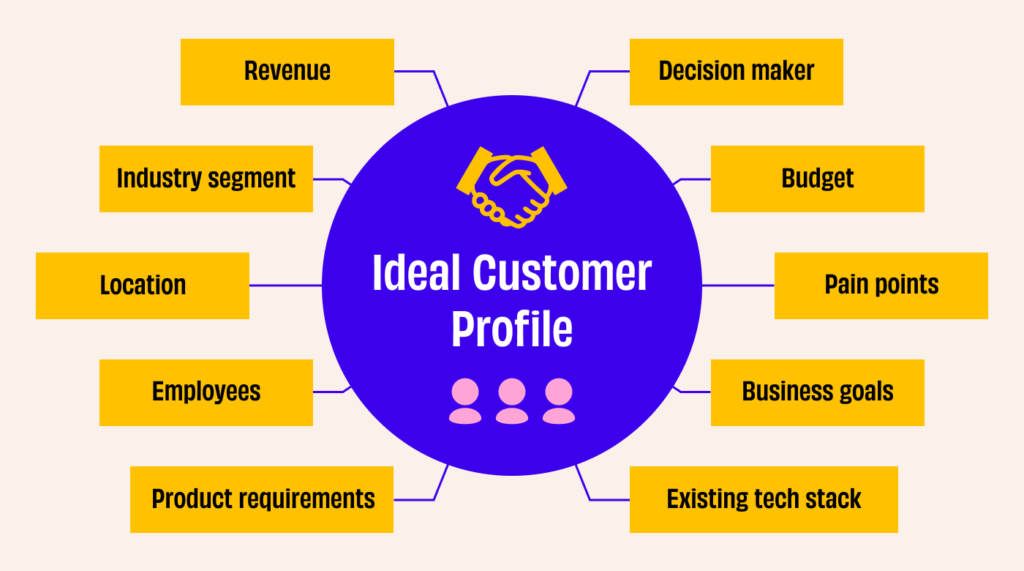
5. Prioritize Target Accounts Likely to Buy
Not all accounts—even if they fit your ICP—will move quickly to buy what you’re selling. The simple truth is that only 5% of B2B accounts are actively looking to buy at any time.
Pushing hard on the other 95% won’t do much. So, how do you identify the most ready-to-buy accounts so you can concentrate your focus and resources?
Whittle down your target account list using the FIRE method:
- Fit: If you’ve already gotten your ICP dialed in, you can skip this step. Otherwise, vet your target accounts based on the characteristics—like size, industry, and job title—that will lead to greater success.
- Intent: Just because an account fits your ICP doesn’t mean they’re necessarily interested in your solution or that the timing is right. Gauge intent using off-website signals like subscriptions to industry publications or attending relevant industry events that hint they may be in the market. Keep an eye out for indirect signals, like job changes within your target accounts; new people within your target roles may be more open to your solution.
- Recency: What was the last point of contact with this account? If they recently attended an event or downloaded a whitepaper, they’re more likely to have the buying process top of mind.
- Engagement: Use signals like inbound website visits, email opens, lead magnet downloads, and social media engagement to keep a big-picture view of ABM engagement. Accounts with lots of engagement signals should be high priorities. Ensure the relevant signals are incorporated into your lead scoring process so that these activities automatically bump those accounts upward in priority.
If you’ve collected large amounts of account data, you can incorporate predictive analytics data into your prioritization to make sense of it all.
6. Set Up a Robust ABM Results Measuring Framework
According to Gartner, measuring the effectiveness of ABM programs is a serious hurdle for 42% of businesses. Marketers say that proving ROI and attribution is their biggest ABM-related challenge.
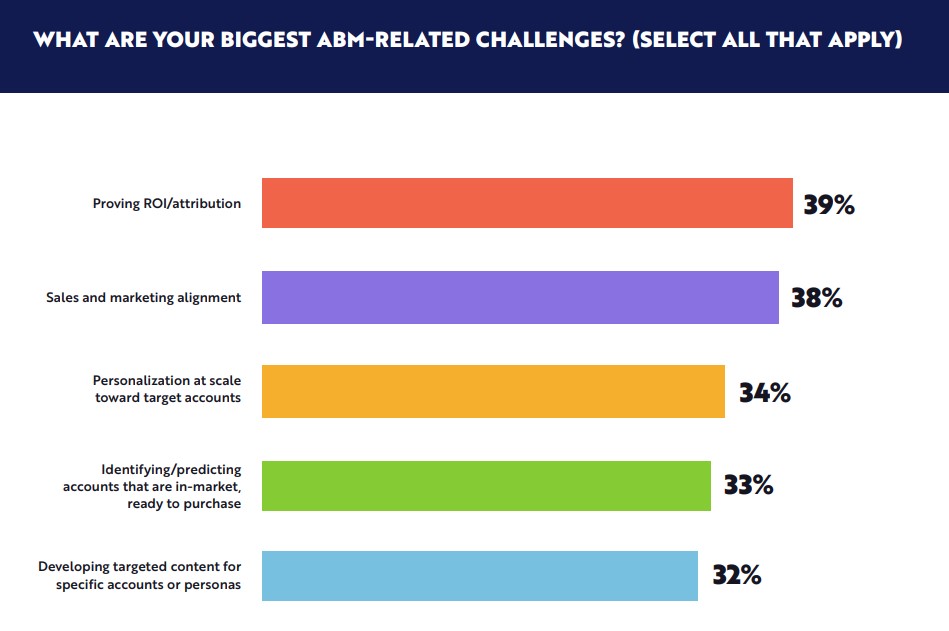
To measure the success of your ABM program and demonstrate ABM’s value to stakeholders, you’ll need to collect meaningful data that matters to all stakeholders.
- Identify metrics: Identify the most relevant metrics for your ABM program, such as account engagement, leads generated, pipeline contribution, revenue attribution, and customer lifetime value. (Do this in collaboration with key stakeholders to ensure the metrics you select are meaningful to everyone.)
- Start tracking: Implement tools and processes for tracking these metrics across various touchpoints and channels.
- Analyze: Regularly analyze the data and use the insights to optimize your ABM strategies.
Not sure which KPIs to focus on? Here are some commonly used KPIs to track ABM program success.
- Target account engagement
- Conversion rate
- Pipeline velocity
- Churn rate
- Customer acquisition cost
- Customer Lifetime Value
- Account coverage
- Average deal size
- Marketing Qualified Accounts (MQAs)
- Account-based ROI
Work with your marketing operations team to build an ABM campaign template to track all these metrics in one place.
ABM Marketing Best Practices
Once you've laid the groundwork with proper planning, it's time to execute your ABM marketing strategies. Here are five ABM best practices to follow:
7. Define Your Marketing Campaign Goals
Your ABM campaign goal might seem obvious: sign deals with new accounts, right?
According to a 2022 study by Momentum ITSMA, a growth consultancy, selling to new accounts is indeed the most common ABM campaign goal. But to determine whether it’s the most effective in your case, you’ll need to work closely with your sales and marketing teams to determine what goals are most pressing.
Other common ABM campaign goals include:
Whichever of these goals makes sense for your campaign, you’ll want to define them further using the specific, measurable, achievable, relevant, and time-bound (SMART) framework.
Above all, remember that account-based marketing is about quality, not quantity. Andy Bacon, a B2B consultant, puts it this way: “ABM is all about building better quality relationships; the ROI will follow.”
8. Select Marketing Channels Your Target Accounts Frequent
Perhaps the biggest mistake you can make in your ABM content strategy —short of targeting the wrong accounts—is trying to reach your audience on the wrong channels.
If you can identify the channels that resonate most with your audience, you’ll have a much better shot at seeing your messaging break through the noise.
Here are the most commonly used ABM channels, according to Demand Gen’s 2022 ABM Benchmark survey:
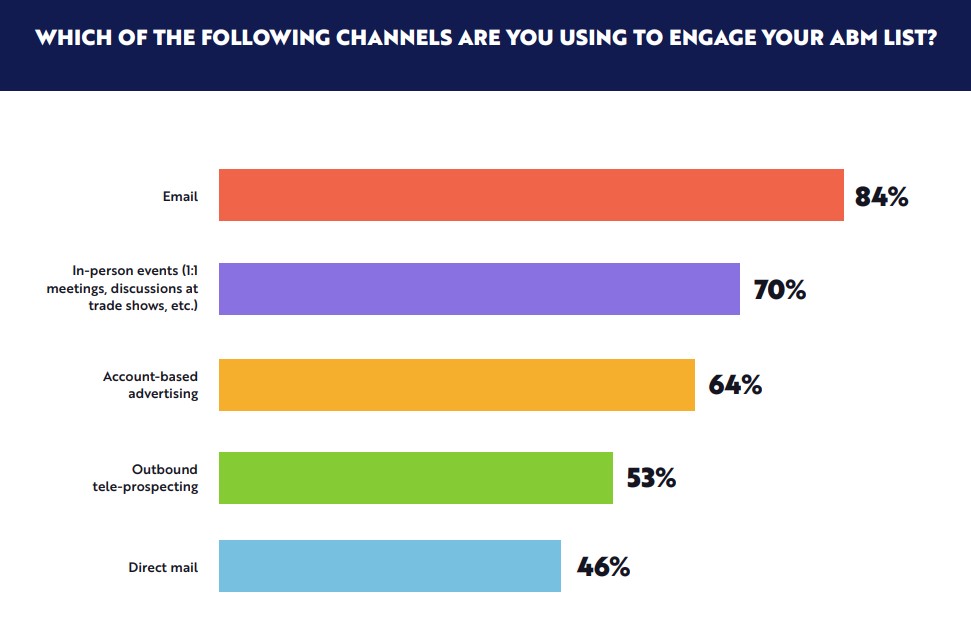
As with all marketing tactics, you can’t treat this as a prescription and follow it blindly. Different audiences demand different marketing mixes. For example, Ironpaper, a B2B marketing agency, has found the most success with a mixture of LinkedIn Ads, email marketing, and partner marketing.
Your ABM campaign should contain a handful of channels to help you reach target accounts on multiple touchpoints; research from Garner has found that integrated campaigns across four or more channels perform best.
To find the mix of channels that works for you, look at data sources like:
- Website analytics
- Social media insights
- Third-party intent data
- Insights from your salespeople
And remember, if you’re running on a limited budget, reaching your audience through low-cost methods can be just as effective.
Sarah Goodall, founder of Tribal Impact, a B2B agency, says, “It shouldn’t always cost big bucks to access accounts… it’s also about building relationships which can be done through social selling and relationship-based marketing.”
9. Build a Sales Enablement Program
Sales enablement is all about helping your sales team close deals more effectively. Your job is to identify the tools and insights that can help them; this is an ongoing job, especially since technology and tools frequently change.
According to Seismic, a sales enablement platform, not giving your sales team enough guidance and resources can come at a serious cost: “We’ve found that sellers without effective enablement spend nearly 10 hours per week tracking down, comparing, or revisiting content to send to buyers. This is valuable time that should be spent engaging with prospects and advancing the goals of the sales team.”
Here are some essential assets to any sales enablement content program:
- Customer insights: Save your sales reps’ time by giving them detailed account information about stakeholders, tech stacks, and customer objectives and pain points. Bring it all together under one roof in your CRM software.
- Training: Educate your sales team on ABM strategies and effective sales techniques. Provide access to sales enablement tools as a central hub for sales training and coaching resources, and consider call recording tools to help coach your team toward better outcomes.
- Content: Researching accounts takes up a ton of your sales team’s time, but crafting relevant sales enablement content comes in at a close second. Provide a library of account-targeted content like pitch decks, case studies, battle cards, and email templates and sequences.
Building a sales enablement program is no small task, but it’s increasingly table stakes for B2B companies: 87% of the companies on the Cloud 100 (a list of the world’s top cloud computing companies) have sales enablement programs.
10. Create Personalized Customer Messaging for Each Target Account
For your ABM messaging to resonate, you need personalized content. But there’s a right way—and a wrong way—to do it. Small tweaks aren’t enough. Renaye Edwards of Digital Radish, an ABM agency, says “A lot of people top and tail content to ‘personalize’ it. True ABM content will transform what your customer is doing, it drives change and an emotional connection.”
Here’s why personalizing your content is worth the effort: 71% of customers expect companies to deliver personalized experiences, and personalization makes 80% of customers more likely to purchase.
It's ABM best practice to tailor content at either the industry-specific or account level. But you can also tailor content toward certain roles. This largely depends on the scope of your ABM program (one-to-many, one-to-few, or one-to-one) and your resources.
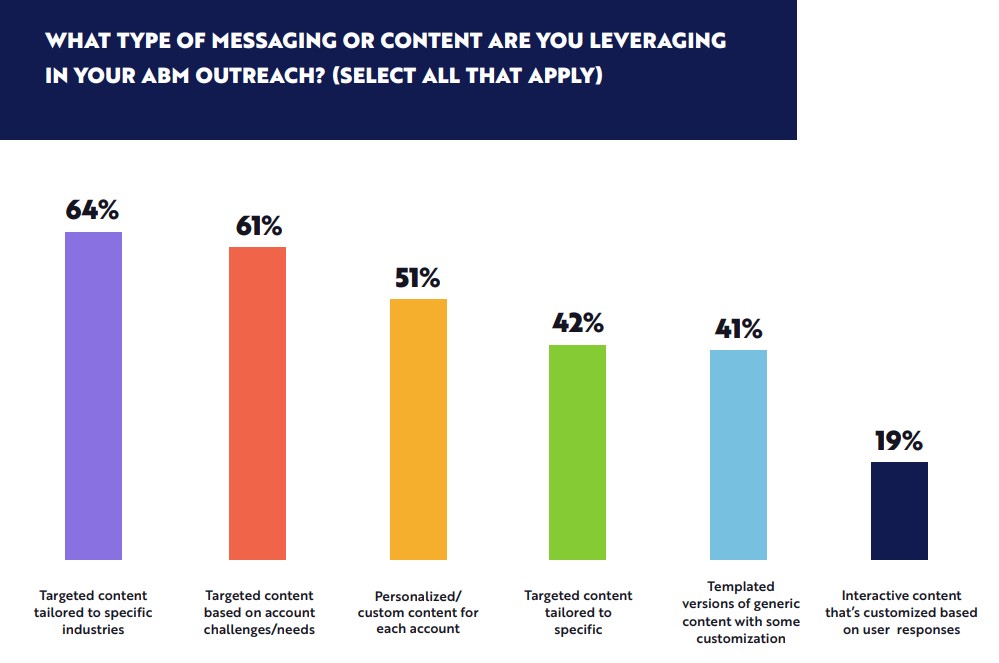
Then, there’s the question of what type of content to use. As always, the answer is “it depends on your audience and goals,” which is why it’s not surprising that 40% of B2B marketers find it challenging to develop the right content for their target audience.
Ironpaper, a B2B marketing agency, tested various strategic approaches and found that the most effective content mediums are white papers, eBooks, infographics, and reports written specifically for the audience. (They’ve also succeeded with repurposing generic content into account-specific variations.)
Meanwhile, Demand Gen’s 2022 ABM Benchmark Survey found that marketers' most used ABM content includes white papers, case studies, articles and blogs, analyst reports, and research. (Direct mail is also a growing channel.)
Check out these account-based marketing examples to get messaging inspiration for your next ABM campaign.
11. Nurture Target Accounts Throughout the Buyer's Journey
Of all the benefits of ABM campaigns, one of the most potent is pipeline expansion. 61% of companies say that ABM results in increased pipeline opportunities, quality, or both, and 75% report that ABM helps them engage with buyers earlier in their buying process.
Why is this? According to Andre Yee of Triblio, an ABM platform, “60-80% of the buyer’s journey is hidden or pre-funnel. But, intent data and ABM can help you proactively target those buyers when they’re showing a propensity to purchase.”
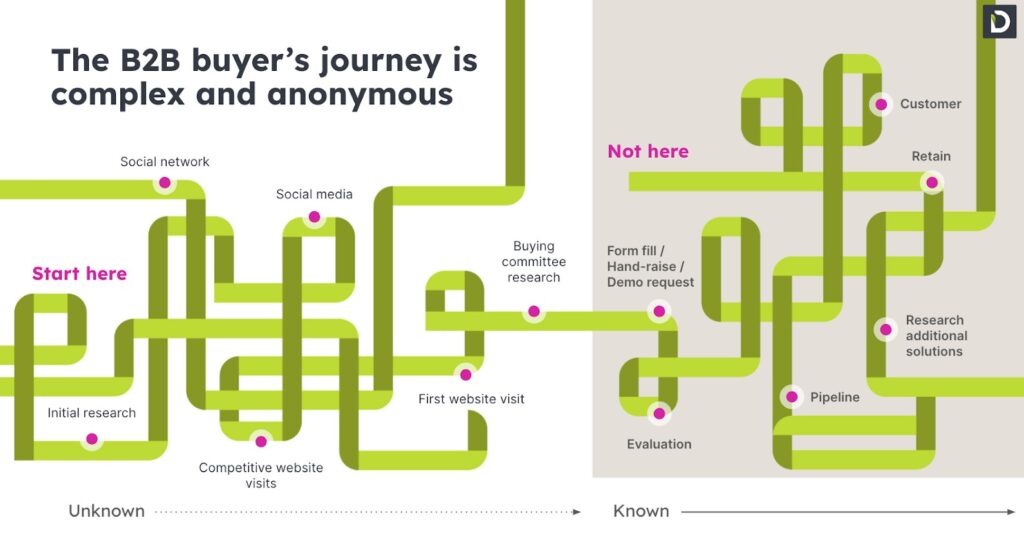
Your job is to nurture accounts as early as possible (even pre-funnel) and for as long as possible, all while using personalized, relevant content. To develop an effective nurture strategy, map out the buyer’s journey for your typical account.
Then, dig into your content library. Find whitepapers, case studies, videos, and other assets that fit each stage of the customer journey, then use marketing automation tools (or sales enablement training) to deliver those assets at the right time.
ABM Tools Best Practices
Without the right tools, your ABM efforts won’t get far. Here are some ABM best practices to keep in mind as you build out your ABM technology stack.
12. Ensure the Tool Integrates Seamlessly with Your Existing Tech Stack
You’ve already got a martech stack, and there’s no need to reconfigure it for the sake of launching your ABM program. One caveat, though: you have to pick an ABM platform that links seamlessly with your existing tools.
Take Triblio, for example, which integrates with Adobe Analytics, Drift, Hubspot, Intercom, LinkedIn, Salesforce, Marketo, and many more.
You’ll also want to watch for tools with preexisting automation, making it easy to connect your tech stack. Rollworks, another ABM platform, offers prebuilt workflows covering many common ABM use cases, like handing off contacts to the sales team, nurturing contacts with email or direct mail, and triggering sales engagement emails.
Here are the general categories of integrations you should look out for:
- CRM & marketing automation
- Conversational marketing (chatbots)
- Site personalization
- Direct mail
- Advertising platforms
- Analytics
Before choosing your ABM platform, run an inventory of your current martech stack, plus any new capabilities you may need to add for your ABM campaign.
Then, look for an ABM platform that covers all your bases. If you need to integrate a lesser-known software, consider using a third-party integration platform like Zapier to connect everything.
13. Ensure the Tool has Robust Analytics and Reporting Capabilities
You can execute an ABM campaign perfectly, but without the data you need to refine it (and show ROI to the C-suite), running a successful campaign long-term will be hard. Plus, according to the ABM Alliance, the most effective ABM programs are 30% more likely to measure ROI.
According to Demand Gen’s ABM Benchmark Survey, most account-based marketers focus on the following core metrics to measure the success of their ABM efforts:
- Number of qualified leads
- Net-new accounts engaged
- Account engagement score
- Contribution to pipeline revenue
- Win rate
Whatever metrics you emphasize, use a tool that gives you the granular data you need to make decisions.
For example, Demandbase ditches “lead-centric measurement” in favor of account-based analytics, like which companies visit your website (and how long they linger).
You’ll also want to ensure your ABM platform gives you a bird's eye view of your campaign progress by showing you how many of your target accounts are in each stage of the pipeline.

14. Ensure the Tool Provides You With High-Quality Data
Comprehensive, up-to-date data helps you populate your ABM target accounts with accurate stakeholder information, personalization-boosting details, and actionable intent data.
Kirsty Dawe of Really B2B, a digital marketing agency, says, “Personalization starts with data. If you don’t have all the insights, you won’t be able to personalize effectively.”
On the other hand, weak data can hamper your personalization efforts and send your sales team on a wild goose chase, resulting in lots of manual research. 43% of marketers say that unreliable data makes it hard to know who to target.
To avoid this, choose ABM tools that give you access to high-quality data sources to make your account research, targeting, and personalized marketing efforts easier.
In addition to basic contact information, look for tools that provide firmographic, technographic, and intent data. Once you’ve got a solid tool, revisit your data regularly: 30% of businesses review their lists quarterly, while 29% do so monthly.
15. Ensure the Tool has Great Customer Support
As much as 50% of sales time is wasted on unproductive prospecting.
ABM helps reduce that number, freeing up your sales team to build customer relationships—but only if your ABM platform and systems are properly set up. If your ABM platform is confusing, complicated, and poorly synced with the rest of your martech stack, your sales team may waste time on something else.
Since ABM tools can be complicated to set up, make sure to choose one with exceptional customer service. The first thing you should do is get a demonstration or trial of the software you’re considering.
Use that experience to gauge the level of customer service. You should also check user reviews on sites like G2 to get a sense of the strengths and shortcomings of each of the platforms you’re considering.
Building an ABM Program that Lasts
Remember this as you move forward with your ABM program: like most marketing methodologies, ABM needs time to deliver results. According to a survey by Dun & Bradstreet, a business analytics firm, realistic timelines are the second-most important factor in ABM's success.
Demand Gen’s 2022 ABM Benchmark Survey found that among marketers with ABM programs over a year old, 59% were satisfied with the outcome; the same was true for only 45% of those who had recently launched their programs.
Adaptability is another key to long-term ABM success, especially regarding AI and machine learning technology. Artificial intelligence has already significantly impacted lead scoring, content personalization, campaign optimization, and analytics. Keep an eye on the latest advances in account-based marketing software to ensure you’re not missing out on any productivity-boosting ABM features.
Check out our cultivated list of account-based marketing podcasts to learn more about ABM. And sign up for The CMO’s Club newsletter for a steady stream of insights designed for forward-thinking marketing professionals.



